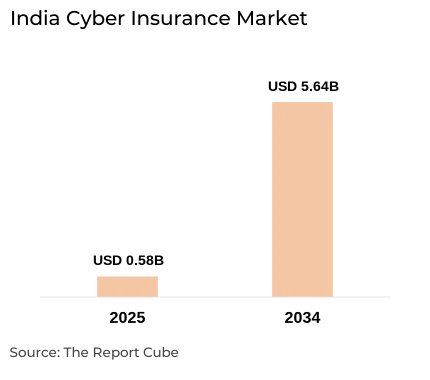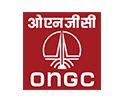
Understand The Key Trends Shaping This Market
Download Free SampleIndia Cyber Insurance Market Overview: Market Size & Forecast (2026–2034)
What is the anticipated CAGR & size of the India Cyber Insurance Market?
The India Cyber Insurance Market is anticipated to register a CAGR of around 28.76% during the forecast period, 2026-34. Additionally, the market size was valued at nearly USD 0.58 billion in 2025 and is projected to reach almost USD 5.64 billion by 2034.
Market Analysis & Insights
As more companies & individuals seek defense against ransomware, social engineering fraud, and data breaches, the India Cyber Insurance Market is expanding swiftly. India recorded about 1.3 million cyberattacks in 2023 (CERT-In), according to industry estimates, with incidents growing by over 15% year over year. Thus, this forced insurer to develop new coverage frameworks. Moreover, in India, cyber insurance covers costs linked with ransomware, cyber extortion, business interruption, and data breaches.
Further, manufacturing, IT & telecom, BFSI, and healthcare are among the major industries that gain prominence across the market by adopting cyber insurance. Furthermore, coverage access is assisted by sales intermediaries such as brokers, internet platforms, and direct sales. Also, leading market companies include Tata AIG, Bajaj Allianz, HDFC ERGO, and ICICI Lombard that contribute in creating a positive market outlook. Additionally, customized policies for individuals & SMEs have been made recently to combat the rise in social engineering fraud. Further, initiatives from the government prioritize cyber risk reduction & CERT-In reporting, hence creating prospects.
Besides. Indian cyber security insurance trends are being influenced by the growing knowledge of cyberattack statistics & business disruption losses, which is echoed in the elevated acceptance of cyber insurance. Thus, this inspires companies to get cyber insurance online across India for comprehensive coverage, further instigating the India Cyber Insurance Market demand.
Furthermore, the India Cyber Insurance Market’s growth is supported by increasing awareness campaigns, accessibility of cyber liability insurance for SMEs India, and the facility to purchase cyber insurance online. Also, with digital transactions climbing & the government aiming at DPDP compliance, the future of cyber insurance in India would center on AI-led risk assessment, real-time incident response, and evolving claims models to address the expanding cyber claims ratio across the country in the future years.
What is the Impact of AI in the India Cyber Insurance Market?
AI is altering Indian Cyber Security Insurance Market trends by enhancing risk profiling, automating underwriting, and detecting fraudulent claims. Also, AI-based analytics aid insurers model ransomware & data breach exposure in real-time.
India Cyber Insurance Market Dynamics
What driving factor acts as a positive influencer for the India Cyber Insurance Market?
- Growing DPDP-Driven Compliance & Risk Transfer Demand: The Digital Personal Data Protection Act (DPDP) 2023's passage has elevated business demand for liability transfer & cyber risk mitigation, thus driving market. Also, the acceptance of customized policies has augmented as a result of the obligation for industries to secure personal data & notify CERT-In of breaches. Also, the BFSI, IT, and healthcare sectors across India are observing sturdy growth due to this regulation change in the demand for dependable cyber insurance coverage.
What are the challenges that affect the India Cyber Insurance Market?
- Low Penetration & Complex Cyber Claims Ratio to Hinder Market: Even though cyberattacks are on the surge in India, less than 1% of all general insurance is covered by cyber insurance. Lack of uniform policy wording, low knowledge, and India's complex cyber claims ratio all hinder implementation, predominantly among SMEs. Additionally, evaluating business interruption losses & assigning liability after a breach continue to be considerable operational challenges for insurers & reinsurers across India's shifting risk environment.

How are the future opportunities transforming the market during 2026-34?
- Increasing SME Adoption & Digital Distribution: The surge of cyber liability insurance for SMEs in India via digital platforms & aggregators has created an untapped growth opportunity for the India Cyber Insurance Market. Further, easy access to acquire cyber insurance online, along with IRDAI’s thrust for digital underwriting, allows insurers to expand low-cost coverage. Thus, this democratization promotes deeper reach across India’s start-up & MSME sectors, substantially enhancing market scalability & resilience.
What market trends are affecting the India Cyber Insurance Market Outlook?
- AI-Powered Underwriting & Automated Risk Analytics: Predictive analytics & AI are being applied by more & more insurers to dynamically price cyber insurance policies in India. Also, companies now customize premiums by scrutinizing social engineering fraud risks, historical breach trends, and network security flaws. Further, the future of cyber insurance in India is being reformed by the incorporation of risk-scoring algorithms, real-time data feeds, and security automation, which redefines operational efficacy.
How is the India Cyber Insurance Market Defined as per Segments?
The India Cyber Insurance Market Research Reports provide detailed market data & insights in accordance with market segmentation. Some of the segments are:
- Type: First-Party Coverage, Third-Party Liability, Data Breach Response, Ransomware Coverage, Business Interruption
- End-User: Small & Medium Enterprises (SMEs), Large Enterprises, Government & Public Sector, Individuals
By Type:
The First-Party Coverage segment captures the prominent market share of around 50% in the India Cyber Insurance Industry.
The segment addresses the direct monetary damages resulting from cyber events such as data breaches, ransomware attacks, and company disruptions. Also, as SMEs are chiefly vulnerable to cyberattacks & need protection against immediate operational & financial effects, it is a vital element in the context of increasing cyber risk awareness.
By End-User:
The Small & Medium Enterprises (SMEs) lead the India Cyber Insurance Market with about 45% market share.
SMEs face rising cyber risk exposure but generally lack satisfactory in-house cybersecurity expertise, motivating dependence on cyber insurance for risk transfer. Also, large enterprises & government sectors make up the rest, usually opting for wide-ranging, customized policies, addressing regulatory compliance & complex cyber risk mitigation needs.
India Cyber Insurance Market: What Recent Innovations Are Affecting the Industry?
- 2025: HDFC ERGO General Insurance launched an AI-enabled CyberSafe 360 Policy incorporating automatic breach response & digital forensics support for businesses.
- 2025: ICICI Lombard General Insurance introduced the Cyber Shield for Businesses, introducing predictive threat modeling & real-time DPDP compliance assessment for large corporate clients.
What are the Key Highlights of the India Cyber Insurance Market (2026–34)?
- The India Cyber Insurance Market CAGR is expected around 28.76% during 2034, with market size reaching USD 5.64 billion by 2034.
- By type, first-party coverage dominates with about 50% market share, covering direct losses such as ransomware & data breach risks.
- By end-user, small & medium enterprises (SMEs) lead with nearly 45% market share owing to amplified cyber risk exposure & narrow internal defenses.
- By industry, BFSI captures the biggest market share of nearly 30%, influenced by critical requirement for cyber risk mitigation & compliance necessities.
- By coverage type, packaged policies seize approximately 60% market share, favored for forthright, all-inclusive cyber insurance coverage.
- By distribution channel, insurance brokers govern with around 40% market share, providing expert guidance & broader market access.
- By policy duration, long-term policies rule the market with over 70% share, favored for ongoing cyber protection.
- By premium range, medium premium range (INR 1-10 Lakh) covers roughly 55% share, complementing affordability & comprehensive
- AI reforms underwriting & cyber claims ratio across the India Cyber Insurance Market.
How does the Future Outlook of the India Cyber Insurance Market (2034) Appear?
- Sustained Growth: Through 2034, the India Cyber Insurance Market would be instigated by rising digital acceptance & compliance with the Digital Personal Data Protection Act (DPDP), further recording nearly 28.76% CAGR (2026-34), and envisioned market value of approx. USD 5.64 bn in 2034.
- Technological Upgrade: AI-driven risk analysis, automated claims, and dynamic cyber risk profiling enhance underwriting accuracy across Cyber Insurance Market in India.
- Future Opportunities: Augmented cyberattacks & regulatory pressure drive demand for customized SME & individual cyber insurance, with AI improving fraud detection & risk mitigation.
The future outlook of the India Cyber Insurance Market is projected to progress, offering both individuals & businesses scalable & reasonably priced security.
What Does Our India Cyber Insurance Market Research Study Entail?
- The India Cyber Insurance Market Research Report highlights the forecast growth rate (CAGR) by anticipating the market size and share.
- The market analysis & market scope sheds light upon the primary industry trends, driving aspects, potential opportunities, growth challenges, and other major factors.
- The India Cyber Insurance Market Research Report entails details about the most critical shifts in market share in the prominent regions.
- Considering the statistics & the developments by the primary market competitors, our report also strives to demonstrate the most sought-after strategies of the key players.
Table of Contents
- Introduction
- Objective of the Study
- Product Definition
- Market Segmentation
- Study Variables
- Research Methodology
- Secondary Data Points
- Companies Interviewed
- Primary Data Points
- Breakdown of Primary Interviews
- Secondary Data Points
- Executive Summary
- Market Dynamics
- Drivers
- Challenges
- Opportunity Assessment
- Recent Trends and Developments
- Policy and Regulatory Landscape
- India Cyber Insurance Market Overview
- Market Size, By Value (in USD Billion)
- Market Share, By Type
- First-Party Coverage
- Third-Party Liability
- Data Breach Response
- Ransomware Coverage
- Business Interruption
- Market Share, By End-User
- Small & Medium Enterprises (SMEs)
- Large Enterprises
- Government & Public Sector
- Individuals
- Market Share, By Industry
- BFSI (Banking, Financial Services & Insurance)
- Healthcare
- IT & Telecom
- Retail & E-commerce
- Manufacturing
- Education
- Others
- Market Share, By Coverage Type
- Packaged (Bundled) Policies
- Stand-alone Policies
- Customized Coverage
- Market Share, By Distribution Channel
- Direct Sales
- Insurance Brokers
- Online Platforms
- Agents
- Market Share, By Policy Duration
- Short-Term Policies
- Long-Term Policies
- Market Share, By Premium Range
- Low Premium (Below INR 1 Lakh)
- Medium Premium (INR 1 Lakh - INR 10 Lakh)
- High Premium (Above INR 10 Lakh)
- Market Share, By Region
- North India
- West and Central India
- South India
- East and Northeast India
- Market Share, By Company
- Revenue Shares
- Competition Characteristics
- India Cyber Insurance Market Overview, 2026-2034
- By Value (USD Billion)
- By Type
- By End-User
- By Industry
- By Coverage Type
- By Distribution Channel
- By Policy Duration
- By Premium Range
- By Region
- Competitive Outlook (Company Profiles)
- HDFC ERGO General Insurance
- Company Overview
- Business Segments
- Strategic Alliances/Partnerships
- Recent Developments
- Bajaj Allianz General Insurance
- Company Overview
- Business Segments
- Strategic Alliances/Partnerships
- Recent Developments
- ICICI Lombard General Insurance
- Company Overview
- Business Segments
- Strategic Alliances/Partnerships
- Recent Developments
- SBI General Insurance
- Company Overview
- Business Segments
- Strategic Alliances/Partnerships
- Recent Developments
- TATA AIG General Insurance
- Company Overview
- Business Segments
- Strategic Alliances/Partnerships
- Recent Developments
- Zurich Kotak General Insurance
- Company Overview
- Business Segments
- Strategic Alliances/Partnerships
- Recent Developments
- Go Digit General Insurance
- Company Overview
- Business Segments
- Strategic Alliances/Partnerships
- Recent Developments
- Others
- Company Overview
- Business Segments
- Strategic Alliances/Partnerships
- Recent Developments
- HDFC ERGO General Insurance
- Contact Us & Disclaimer
List of Figure
Figure 1.1: Objective of the Study
Figure 1.2: Product Definition of Cyber Insurance
Figure 1.3: Market Segmentation Overview
Figure 1.4: Study Variables
Figure 2.1: Research Methodology Flowchart
Figure 2.2: Secondary Data Sources
Figure 2.3: Companies Interviewed for Secondary Research
Figure 2.4: Primary Data Collection Breakdown
Figure 2.5: Distribution of Primary Interviews
Figure 3.1: Executive Summary Snapshot
Figure 4.1: Key Market Drivers
Figure 4.2: Challenges in the India Cyber Insurance Market
Figure 4.3: Opportunity Assessment Matrix
Figure 5.1: Recent Trends and Developments in Cyber Insurance
Figure 6.1: Policy and Regulatory Landscape Overview
Figure 7.1: India Cyber Insurance Market Size (USD Billion)
Figure 7.2: Market Share by Type
Figure 7.2.1: First-Party Coverage Share
Figure 7.2.2: Third-Party Liability Share
Figure 7.2.3: Data Breach Response Share
Figure 7.2.4: Ransomware Coverage Share
Figure 7.2.5: Business Interruption Coverage Share
Figure 7.3: Market Share by End-User
Figure 7.3.1: SMEs vs Large Enterprises vs Government vs Individuals
Figure 7.4: Market Share by Industry
Figure 7.4.1: BFSI
Figure 7.4.2: Healthcare
Figure 7.4.3: IT & Telecom
Figure 7.4.4: Retail & E-commerce
Figure 7.4.5: Manufacturing
Figure 7.4.6: Education
Figure 7.4.7: Others
Figure 7.5: Market Share by Coverage Type
Figure 7.5.1: Packaged Policies
Figure 7.5.2: Stand-alone Policies
Figure 7.5.3: Customized Coverage
Figure 7.6: Market Share by Distribution Channel
Figure 7.6.1: Direct Sales
Figure 7.6.2: Insurance Brokers
Figure 7.6.3: Online Platforms
Figure 7.6.4: Agents
Figure 7.7: Market Share by Policy Duration
Figure 7.7.1: Short-Term Policies
Figure 7.7.2: Long-Term Policies
Figure 7.8: Market Share by Premium Range
Figure 7.8.1: Low Premium (< INR 1 Lakh)
Figure 7.8.2: Medium Premium (INR 1–10 Lakh)
Figure 7.8.3: High Premium (> INR 10 Lakh)
Figure 7.9: Market Share by Region
Figure 7.9.1: North India
Figure 7.9.2: West & Central India
Figure 7.9.3: South India
Figure 7.9.4: East & Northeast India
Figure 7.10: Market Share by Company
Figure 7.10.1: Revenue Shares of Key Players
Figure 7.10.2: Competitive Landscape Characteristics
Figure 8.1: India Cyber Insurance Market Forecast (2026–2034) – By Value
Figure 8.2: Market Forecast by Type
Figure 8.3: Market Forecast by End-User
Figure 8.4: Market Forecast by Industry
Figure 8.5: Market Forecast by Coverage Type
Figure 8.6: Market Forecast by Distribution Channel
Figure 8.7: Market Forecast by Policy Duration
Figure 8.8: Market Forecast by Premium Range
Figure 8.9: Market Forecast by Region
Figure 9.1: HDFC ERGO General Insurance – Company Overview
Figure 9.2: Bajaj Allianz General Insurance – Company Overview
Figure 9.3: ICICI Lombard General Insurance – Company Overview
Figure 9.4: SBI General Insurance – Company Overview
Figure 9.5: TATA AIG General Insurance – Company Overview
Figure 9.6: Zurich Kotak General Insurance – Company Overview
Figure 9.7: Go Digit General Insurance – Company Overview
Figure 9.8: Other Key Players – Overview
List of Table
Table 1.1: Study Objectives
Table 1.2: Product Definition
Table 1.3: Market Segmentation
Table 1.4: Study Variables
Table 2.1: Secondary Data Sources
Table 2.2: Companies Interviewed for Secondary Research
Table 2.3: Primary Data Points
Table 2.4: Breakdown of Primary Interviews
Table 4.1: Key Market Drivers
Table 4.2: Challenges in the India Cyber Insurance Market
Table 4.3: Opportunity Assessment
Table 5.1: Recent Trends and Developments
Table 6.1: Policy and Regulatory Landscape
Table 7.1: India Cyber Insurance Market Size (USD Billion)
Table 7.2: Market Share by Type
Table 7.2.1: First-Party Coverage Share (%)
Table 7.2.2: Third-Party Liability Share (%)
Table 7.2.3: Data Breach Response Share (%)
Table 7.2.4: Ransomware Coverage Share (%)
Table 7.2.5: Business Interruption Coverage Share (%)
Table 7.3: Market Share by End-User
Table 7.3.1: SMEs vs Large Enterprises vs Government vs Individuals
Table 7.4: Market Share by Industry
Table 7.4.1: BFSI
Table 7.4.2: Healthcare
Table 7.4.3: IT & Telecom
Table 7.4.4: Retail & E-commerce
Table 7.4.5: Manufacturing
Table 7.4.6: Education
Table 7.4.7: Others
Table 7.5: Market Share by Coverage Type
Table 7.5.1: Packaged Policies
Table 7.5.2: Stand-alone Policies
Table 7.5.3: Customized Coverage
Table 7.6: Market Share by Distribution Channel
Table 7.6.1: Direct Sales
Table 7.6.2: Insurance Brokers
Table 7.6.3: Online Platforms
Table 7.6.4: Agents
Table 7.7: Market Share by Policy Duration
Table 7.7.1: Short-Term Policies
Table 7.7.2: Long-Term Policies
Table 7.8: Market Share by Premium Range
Table 7.8.1: Low Premium (< INR 1 Lakh)
Table 7.8.2: Medium Premium (INR 1–10 Lakh)
Table 7.8.3: High Premium (> INR 10 Lakh)
Table 7.9: Market Share by Region
Table 7.9.1: North India
Table 7.9.2: West & Central India
Table 7.9.3: South India
Table 7.9.4: East & Northeast India
Table 7.10: Market Share by Company
Table 7.10.1: Revenue Shares of Key Players
Table 7.10.2: Competitive Landscape Characteristics
Table 8.1: India Cyber Insurance Market Forecast (2026–2034) – By Value
Table 8.2: Market Forecast by Type
Table 8.3: Market Forecast by End-User
Table 8.4: Market Forecast by Industry
Table 8.5: Market Forecast by Coverage Type
Table 8.6: Market Forecast by Distribution Channel
Table 8.7: Market Forecast by Policy Duration
Table 8.8: Market Forecast by Premium Range
Table 8.9: Market Forecast by Region
Table 9.1: HDFC ERGO General Insurance – Key Metrics
Table 9.2: Bajaj Allianz General Insurance – Key Metrics
Table 9.3: ICICI Lombard General Insurance – Key Metrics
Table 9.4: SBI General Insurance – Key Metrics
Table 9.5: TATA AIG General Insurance – Key Metrics
Table 9.6: Zurich Kotak General Insurance – Key Metrics
Table 9.7: Go Digit General Insurance – Key Metrics
Table 9.8: Other Key Players – Key Metrics
Top Key Players & Market Share Outlook
- HDFC ERGO General Insurance
- Bajaj Allianz General Insurance
- ICICI Lombard General Insurance
- SBI General Insurance
- TATA AIG General Insurance
- Zurich Kotak General Insurance
- Go Digit General Insurance
- Others
Frequently Asked Questions








